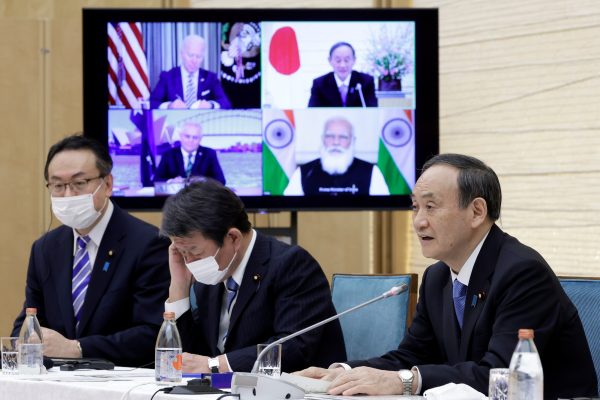Fast forward to 2017, the Quad regained significance when the United States relaunched its Indo-Pacific vision of Asian cooperation, with the Quad as its linchpin. In 2004, as in 2017, thwarting China’s diplomatic inroads into its Asian peripheries was the Quad’s overarching mission. This is worth keeping in mind amid the low expectations widely interpreted of the Quad’s first in-person summit since the start of the COVID-19 pandemic, which took place on 24 September 2021.
The difference between the two benchmark dates lay in Australia’s initial pivot towards Chinese trade, investment and tourism. India had also vacillated between outright hostility towards Beijing and nuanced deterrence against it. It took the advent of the Trump administration to re-energise the Quad as an anti-China vehicle. By that time, Japan was gradually seeing value in framing relations with Beijing as both friend and enemy, ripe with cooperative possibilities between the two ends of the spectrum. The current Biden administration appears to have hardened its support of the Quad while deftly playing down a Cold War posture towards China. These fissiparous tendencies ironically served the Quad well by not straightjacketing its members’ foreign policy flexibility while putting China on notice that an anti-China alliance remained latent.
Meanwhile, China witnessed President Xi Jinping’s ascent to power in 2013. Despite incremental moves towards strident nationalism under his predecessors Jiang Zemin and Hu Jintao, it was Xi who shifted Chinese foreign policy to a more pronounced and combative nationalistic posture. Red hot economic growth buoyed Xi’s legitimacy and underpinned his avowed aim of definitively turning the page on China’s century of humiliation. Xi’s vision of the land and maritime transcontinental linkages of the Belt and Road Initiative found almost unbridled receptivity across Southeast and South Asia.
Under former prime ministers Tony Abbott and Malcolm Turnbull, Australia entertained Chinese investment to expedite infrastructural upgrades in Northern Australia. India under Prime Minister Narendra Modi even sought to overlook the multiple Sino–Indian military skirmishes in the Himalayas to host Xi at summits with the purpose of enticing Chinese trade and investment. ASEAN too felt comfortable encouraging these trends of ‘coopetition’ to the point of drafting an all-inclusive and politically correct declaration titled the ‘ASEAN Outlook on the Indo-Pacific’.
When Quad leaders met at the White House on 24 September, they pledged cooperation and support for expanded vaccine delivery and climate change amelioration. They also stepped-up international sharing of technical standards, 5G information technology diversification and deployment, horizon-scanning and technology supply chains. All of these are standard liberal promises that are par for the course in most Asian diplomatic circuits. But most importantly, they chimed in with ASEAN’s discourse of ‘ASEAN centrality’, inclusive regionalism and the avoidance of naming the proverbial 800-pound gorilla in the Indo-Pacific.
Against this pattern, the announcement the week before the Quad summit of the AUKUS (Australia, the United Kingdom and the United States) trilateral partnership and nuclear submarine deal represents a strategic disruption that potentially negates what the Quad is trying to achieve vis-a-vis China. Functional cooperation in Asia in tandem with omnidirectional economic cooperation has been ditched in favour of triggering a potential arms race redolent of the Cold War. AUKUS explicitly signalled its intent to deter China militarily. Disturbingly, the fine details spelled out through the grouping’s desired submarine capabilities suggested that concepts such as countervailing retaliation and mutual assured destruction are in play.
This flies in the face of evidence that ASEAN and most of China’s Asian neighbours have long grown accustomed to living with and managing China’s expectations about its ‘peaceful ascent’ as a great power. ASEAN’s posture of preaching and practising open and inclusive regionalism had even earned ringing endorsements from Washington, Beijing, Tokyo, Moscow and New Delhi since the mid-1990s. Even more recently, the assorted French, German and European Union declarations on the Indo-Pacific reiterated support for the peaceful fluidity of great power relations.
The Quad also served this imperfect but durable neighbourhood peace. But the advent of AUKUS may well undermine this state of relative tranquillity — to the chagrin of much of the Indo-Pacific.
A Chong is a political commentator based in Singapore.


There is no irreconcilability problem between the two. AUKUS does hard security in Western Pacific; the QUAD does softer trade, technology and regional public goods provision.
Because the region’s economic and public goods networks in almost all instances run through Beijing, no matter how much some might want it otherwise (New Delhi is not part of APEC, CMIM, RCEP, CPTPP and Washington is not part of the last three either), the QUAD will remain a red shiny object of limited utility. On the other hand, AUKUS serves a real deterrent purpose and will become a permanent feature of the Western Pacific’s – not Indian Ocean or Indo-Pacific’s – architecture.
Insofar as ASEAN is concerned, most of AUKUS’ work is happening above ASEAN’s paygrade. Hence, no point engaging in hand-wringing. Rather ASEAN should focus on AUKUS’ non-proliferation, maritime law (seabed survey activity), and navigation security and traffic separation-related dimensions in its own neck of the woods and try to set rule/norm-making in this regard.
“Reconciling the Quad and AUKUS” – why would anyone wanna do that, 2 very belligerent, warmongering and destabilising imperialist-neo-colonialist constructs?
What if there was a Latin Quad of Cuba, Venezuela, China, Argentina and maybe Bolivia? These countries would have to be much more economically improved of course.